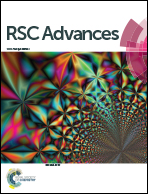Highly luminescent, off-stoichiometric CuxInyS2/ZnS quantum dots for near-infrared fluorescence bio-imaging†
Abstract
Quantum dots (QDs) are very attractive for in vivo bio-imaging and therapeutic applications due to their relatively large absorption coefficient, high quantum yield, low level of photo bleaching, and large Stokes shift. However, two technical issues need to be resolved before they can be practically applied to in vivo bio-imaging applications: ensuring both reduced toxicity and efficient emission in the near-infrared (NIR) frequency range. Here we report a simple and reliable method to synthesize highly luminescent, NIR-emitting CuxInyS2/ZnS (CIS/ZnS) core–shell QDs for deep-tissue bio imaging applications. Off-stoichiometric effects are utilized with 1-dodecanethiol as a reaction medium for thermolytic synthesis. The most important finding in our work is that at a high Cu/In ratio, the emission spectrum of CIS/ZnS QDs can be tuned to NIR frequencies with a high quantum yield up to approximately 65%. The maximum emission wavelengths of the synthesized QDs are 589 nm (QD589) and 726 nm (QD726) at a Cu/In ratio of 0.25 and of 1.8, respectively. Their feasibility for optical bio-imaging in a deep-tissue condition is investigated by the intramuscular injection of QD-loaded polymer microspheres in a mouse model. Our results show that more than 30% of the original emission of the QD726 can be detected through biological tissue of 0.9 cm, whereas emission from the QD589 is not detectable. Our investigation on the off-stoichiometric effects of CIS QDs will contribute to the development of highly luminescent, NIR-emitting, cadmium-free QDs in the areas of tissue-level imaging, sensing, and therapeutics.


 Please wait while we load your content...
Please wait while we load your content...